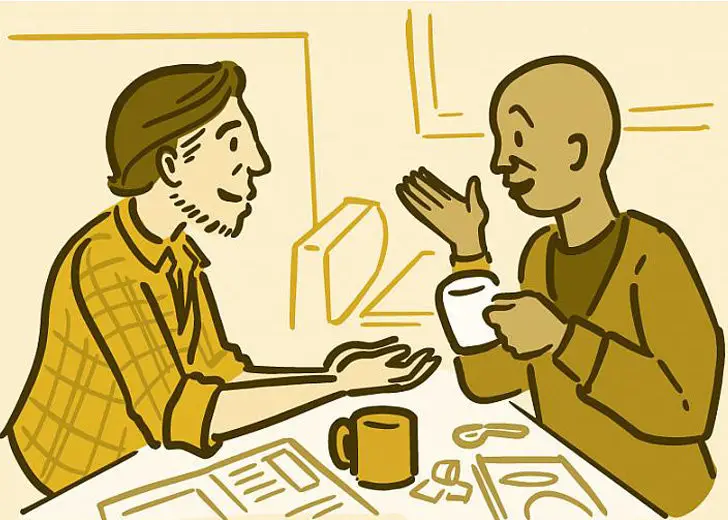Communication Skills Techniques: How To Build Good First Impression?

When we meet people for the first time, we all want to make an excellent first impression. Whether it is a job interview or a first date, we know the basics: be a friendly persona, smile, maintain eye contact, and generally treat others the way you’d like to be treated.
That’s all well and good, but there are smaller, much more critical things that we can cultivate in us to be a better communicator.
In this article, we will aim to learn approaches that will help us to understand the individual differences during a communication process. Let’s get started.
Body Language
“It’s not what you say, it’s how you say it” is a common phrase we might have heard before. This is especially true In a face-to-face scenario—where we tend to look at the person who is talking to us and pick up on their non-verbal cues.
When it comes to human interactions, about 60-65% of conversations rely on body language. So, how do you use your body language to cultivate relationships with people? Here are a few tips and tricks you can use.
Mirroring
Mirroring involves copying the gestures and behaviors of others during or before a conversation.
For example, someone may be sitting with an arm over the back of the chair. The person might point to their eyes while talking about the greatness of their new pair of glasses.
Try mimicking the person gestures and body movements while you talk to them. If you are talking about the glass with the person mentioned above, you might want to pick up on the person’s gestures and apply it to yourself.
This makes a ton of difference because of the “chameleon effect.”
What Is the Chameleon Effect?
The chameleon effect is something that occurs unconsciously when two people are in rapport with each other. When you showcase body movements and gestures similar to the other person, this sends a message to the person that you are similar to them and makes them trust you more.

Open Posture
While talking to the other person, make sure your arms are not crossed.
From the perspective of evolutionary psychology, crossing your arms means you are hiding your most vulnerable areas—the upper thoracic region where all the vital organs are located. This sends an unconscious signal to the other person’s brain that you are feeling threatened or that you do not trust them.
Eye contact
Did you know that children actually look at people’s eyes to find out if they are being deceptive? They tend to carry this trait into their adulthood.
Although the lack of eye contact is no longer considered a sign of lying or deception, it is taken into consideration in the process known as baseline analysis.
The person implementing the process or conducting a baseline study looks after the deviation in eye movement and overall behaviors (especially face, mouth, and body movement) of the interviewee at the time the individual is asked what we know as trigger questions.
But Does a Lack of Eye Contact Means a Lack of Confidence?
If a person hasn’t been diagnosed with any mental health condition, the individual may be shy or lacking in confidence if they showcase eye contact anxiety of any kind.
Why Eye Contact Is Important While Communicating?
Generally, we communicate better or make our point land clearer when we look in the eye of the other person while conversing. Of course, we also have to match our tone, speech, and body movements accordingly if we wish to portray confidence and sincerity in our expression.
How Much Eye Contact Is Enough?
We shouldn’t make repeated eye contacts just to test the limits of another person. Having proper communication means that you are clear about the message and communication cues you want to deliver to others.
In a casual or day to day conversation, you should develop a normal eye contact habit.
If you are finding it hard to look into the eyes of others, just remember that it is reasonable to make eye contact and suddenly look away when we are thinking or planning what to say next. But don’t forget, we should maintain eye contact when we are speaking or communicating our points and ideas to the other person.
Touch
Research has shown that touch can convey many different things, including power, dominance, relatability, love, affection, or danger, depending on the context.
So the next time you’re on a date, do not hesitate to give him/her a high-five. Or, you would also want to convey your professionalism through a good handshake.
Verbal Communication.
Just because 60-65% of communication relies on body language does not mean that your verbal communication does not matter. If you use your words carefully, they can have a significant effect on others. These are some habits and advice you can consider when talking to someone.

Paraphrasing
Paraphrasing is an art of weaving in keywords that the person has used in their speech into your own. This shows that you are a good listener and are validating their efforts in communicating with you. Here’s an example of how you can use paraphrasing:
Dave: Hawaii was great, man, I went to this spa that used hot rocks for therapy. Who would’ve thought?
You: Really? Hot rocks? How does that work?
Dave: Well, you lie on your belly, and they place hot rocks on your back. Really opens up knotted up muscles.
You: Huh. Who would’ve thought? I’ve got knots on my back too.
Dave: Yeah, you might be able to find someone here too. You know this.
In the text form, this conversation looks absolutely bizarre; but take a look at the use of keywords here, “hot rocks” and “knotted back.”
These words have a lot of emotional value for Dave, and when you talk about them, this would definitely launch Dave into talking about himself more. Using his phrase “Who would’ve thought?” in your sentence after a few lines tell Dave that you have been listening.
Summarising
Summarising somewhat looks like paraphrasing, but the two are completely different strategies. While paraphrasing uses keywords, summarizing involves taking a topic someone has said and describing it back to them in a short manner.
For example, you can use summarising in the same context as above. You could say, “So you went to Hawaii and had hot stones on your back? That’s brilliant!” This summarizes the gist of what Dave is saying. This quick summer from your side also shows him that you have valued his experiences.
This approach also helps in clarifying what you might have misunderstood in the conversation and enables you to be a better listener.
Questioning:
Since many of us like to talk about ourselves, the questioning process helps in exploring the person before you and their perspectives. It also gets them to share a lot of things with you, and that is what creates rapport. There are two ways you can do this:
-
Using Open-Ended Questions: These types of questions elicit a more extended answer from the person. For example, “How did you feel about your vacation?” inspires a longer answer from the speaker and ensures their involvement in the conversation.
-
Using Closed-Ended Questions: These types of questions elicit a shorter answer from the person. For example, “Did you have breakfast today?” inspires a one-word response from the speaker.
This form of questioning usually allows you to remain in control of the conversation and is not as effective to encourage two-way communication.
The Takeaway
Communication has always been a key factor in the evolution of human beings. The evolution of speech was crucial in the development and passing down of knowledge to newer generations.
But in this day and age, better communication helps us to gain success in our career, personal life, r social relationship.
Remember, the basis of good communication skills relies on how you validate the people around you. When you use these skills in your day to day conversation, you will definitely see some changes and the way people respond to you.
Note: This article isn’t suggesting you engage in unnecessary conversations with other people without the need for communication. Communication isn’t about forcing yourself or others to an undesired state. Instead, it’s about being true to our roles, responsibilities, values, and beliefs in life.